Wyoming, a mountainous state in the western United States, is renowned for its pristine natural beauty and incredible biodiversity. It’s not only an attractive tourist destination but also a treasure trove of unique ecosystems, drawing the attention of scientists and nature enthusiasts worldwide. From dense forests to vast grasslands, from majestic mountain ranges to magical hot springs, Wyoming’s ecosystem offers countless fascinating things to explore. This article will take you on a journey to discover the outstanding features of the Wyoming ecosystem, a wondrous land full of surprises.
Yellowstone – The Jewel of Wyoming’s Ecosystem
Speaking of Wyoming, one cannot ignore Yellowstone National Park, a symbol of wild beauty and the heart of the local ecosystem. Established in 1872, Yellowstone is not only the first national park in the United States but also in the world, demonstrating the invaluable historical and natural value it holds. Spanning a vast area of nearly 9000km2, Yellowstone stretches across most of northwestern Wyoming, also extending into small parts of Montana and Idaho. However, Wyoming remains its primary cradle, the place where the park’s most characteristic and diverse landscapes are concentrated.
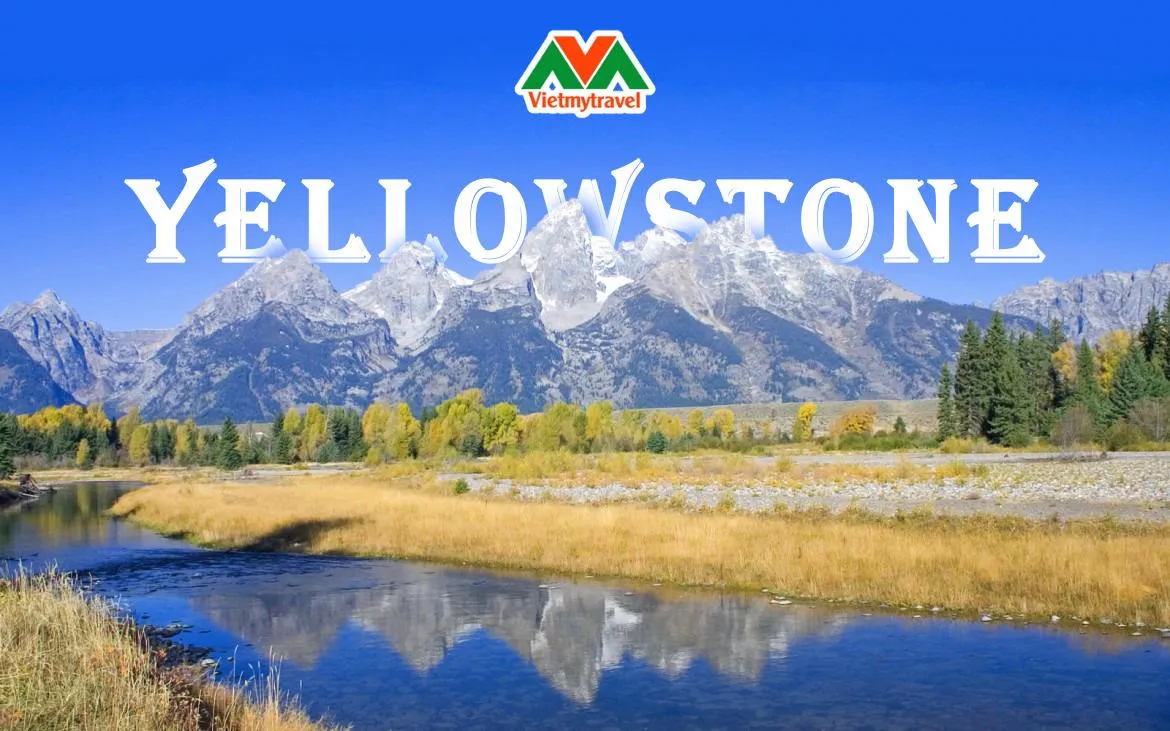
Yellowstone is a miniature world with the convergence of many different ecosystems, from forests, grasslands, lakes to unique geothermal areas. This diversity creates an ideal habitat for countless species of flora and fauna, making Yellowstone one of the most important nature reserves on the planet. Its long history of formation, starting over 11,000 years ago, has allowed the ecosystem here to develop naturally and sustainably, with minimal human impact. Archaeologists have found ancient fossils along Yellowstone Lake, confirming the long history and richness of the ecosystem here.
Old Faithful Geyser and Unique Geothermal Wonders
Wyoming boasts one of the most active geothermal areas in the world, and Yellowstone is the epicenter of these amazing geothermal phenomena. With over 300 geysers, accounting for half of the world’s total, Yellowstone deserves to be called the “geyser capital” of the world. Among them, the most famous is Old Faithful Geyser, a symbol of the park and of the entire Wyoming ecosystem.
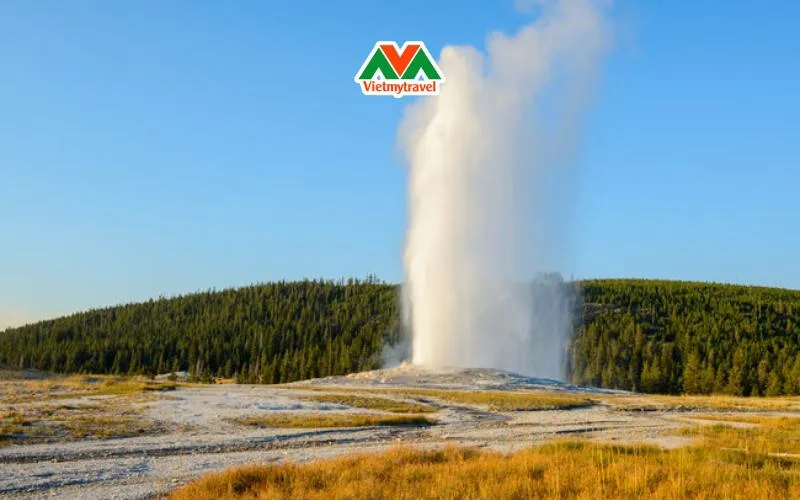
Old Faithful erupts regularly every 90 minutes, shooting hot water columns up to 45 meters high. This miraculous phenomenon has been happening for thousands of years, attracting millions of visitors to admire each year. The stability and spectacularity of Old Faithful is not only a wonderful natural spectacle but also evidence of the powerful geothermal system beneath Wyoming’s soil. Other hot springs in Yellowstone also contribute to creating a unique landscape, diverse in colors and shapes, from blue hot springs to bubbling mud pots, all of which are indispensable elements of the Wyoming ecosystem.
The Most Diverse Flora and Fauna Ecosystem
Wyoming prides itself on possessing an extremely rich and diverse ecosystem of flora and fauna. Yellowstone, with 80% of its area being forest and over 10% grassland, is an ideal habitat for thousands of species. Forests in Yellowstone are mainly coniferous forests, accounting for 80% of the forest area, creating a vast green color covering most of the park. In addition, there are about 170 invasive plant species and countless other native plant species, including the rare Yellowstone sand verbena.

Not only plants, but animals in Wyoming are also extremely diverse. Yellowstone is home to about 300 species of birds, 67 species of mammals, and 16 species of fish. Among them are many rare and endangered species such as gray wolves, lynx, elk, and grizzly bears. Visitors to Yellowstone have the opportunity to witness these wild animals in their natural environment. In particular, Wyoming is one of the few remaining places in the United States where bison still live. This animal has existed since prehistoric times and still thrives in the Wyoming ecosystem. The image of herds of bison leisurely moving on the road has become a unique feature of Yellowstone in particular and Wyoming in general. The conservation of these rare flora and fauna species is an important part of maintaining the balance of the Wyoming ecosystem.
Yellowstone Supervolcano and Unique Terrain
Located on the caldera of a still-active supervolcano, Yellowstone is a very special geological area. The most recent major volcanic eruption occurred about 70,000 years ago, and currently, the volcano is still in a state of underground activity. Although there are no major eruptions, geothermal activity still creates minor earthquakes and aftershocks, contributing to the formation of unique and diverse terrain for Wyoming.
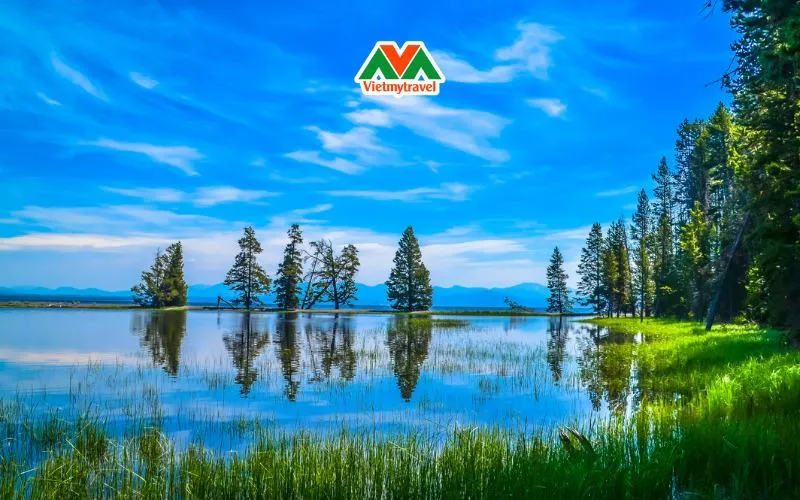
Yellowstone Lake, the largest freshwater lake in North America located above sea level, is one of the clearest proofs of volcanic activity here. The lake has a large area and incredible depth, containing a rich underwater ecosystem. Besides Yellowstone Lake, the park also has 290 large and small waterfalls, of which the highest waterfall is the Lower Falls of the Yellowstone River with a height of 94 meters. These waterfalls not only create majestic landscapes but also play an important role in providing water and maintaining life for the surrounding ecosystem. The combination of geological activity and hydrological factors has created a unique and diverse Wyoming ecosystem.
Grand Prismatic Spring – A Miraculous Natural Palette
One of the most famous natural wonders of Yellowstone and Wyoming is the Grand Prismatic Spring. This is the largest hot spring in the United States and the third largest in the world, nổi bật with the brilliant beauty of rainbow colors. With a diameter of 110 meters and a depth of 50 meters, Grand Prismatic attracts visitors with its diverse colors, from orange-red in summer to deep blue in winter.
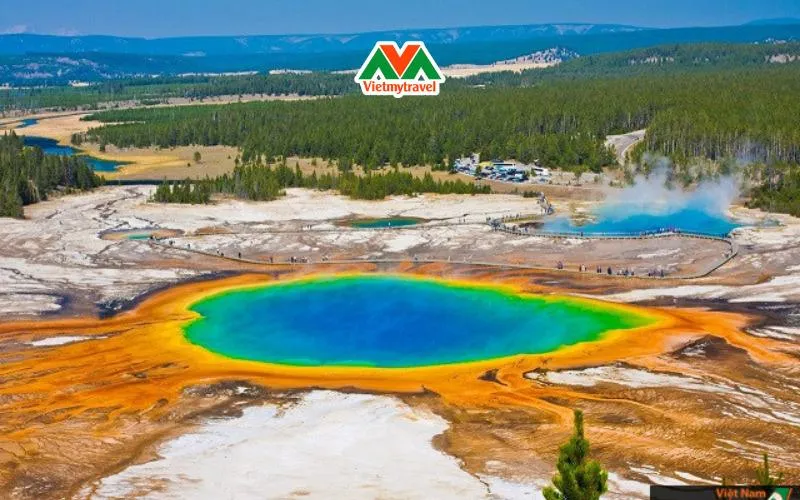
The miraculous colors of this hot spring are created by thermophilic bacteria living in the water. Each species of bacteria thrives at a different temperature and creates a distinct color, creating a natural palette that is extremely unique and attractive. Standing before the beauty of Grand Prismatic, visitors will feel like they are lost in another world, where color and nature blend together to create a masterpiece of art. This hot spring is not only a famous tourist destination but also an important part of Wyoming’s unique geothermal ecosystem.
Grand Canyon of the Yellowstone – A Majestic Masterpiece Beyond Time
Not only famous for hot springs and geysers, Wyoming also possesses another magnificent natural wonder – the Grand Canyon of the Yellowstone. This canyon was formed by the erosion of the Yellowstone River over millions of years, creating vertical cliffs with many different colors, especially bright golden yellow. With a length of over 32km and an impressive depth, the Grand Canyon of the Yellowstone is a must-visit destination for those who love adventure and nature exploration.

The Yellowstone River flows swiftly through the canyon, creating majestic waterfalls and contributing to the diversity of the ecosystem here. The Grand Canyon is not only a beautiful natural landscape but also a living geological history book, recording the formation and development of the Wyoming region over millions of years. The combination of deep canyons, powerful rivers, and diverse ecosystems has created a unique Grand Canyon, bearing the bold imprint of Wyoming.
Diverse Experiences in the Heart of Wyoming’s Ecosystem
The Wyoming ecosystem is not only a treasure of precious nature but also an attractive tourist destination with countless exciting experiences. Visitors can explore Yellowstone Lake by boat, admire the majestic beauty of the mountains, and enjoy the fresh air of nature. Kayaking on the lake, fishing, or simply hiking along the lake are all popular activities.
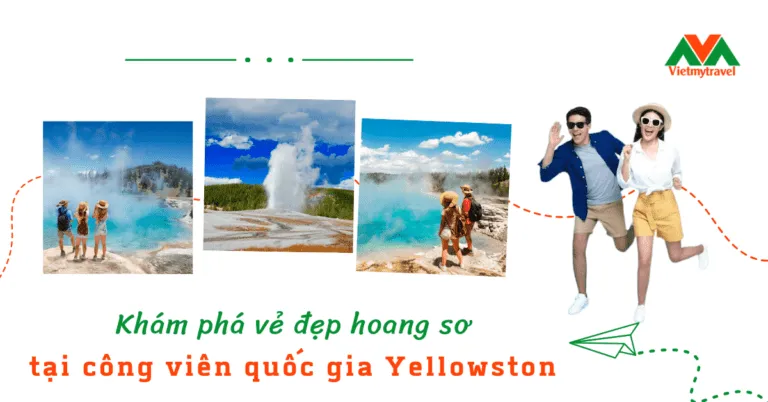
In addition, wildlife viewing is also an unmissable experience when visiting Wyoming. Visitors can join eco-tours to observe bison, elk, bears, and many other animals in their natural environment. Yellowstone and Wyoming in general are a paradise for nature photography enthusiasts, with countless beautiful and unique shooting angles. From sunrise on mountain peaks to sunset on lakes, every moment in Wyoming is a work of art of nature.
Conclusion
The Wyoming ecosystem is a colorful and vibrant natural painting. From unique geothermal wonders like Old Faithful and Grand Prismatic to the rich and diverse flora and fauna ecosystem, Wyoming offers unforgettable experiences for anyone who sets foot in this land. Exploring and conserving the Wyoming ecosystem is not only the responsibility of local people but also of the international community, so that future generations can continue to admire and enjoy the pristine and magical beauty of this land. Come and discover Wyoming, to feel the majesty of nature and the diversity of wildlife here.